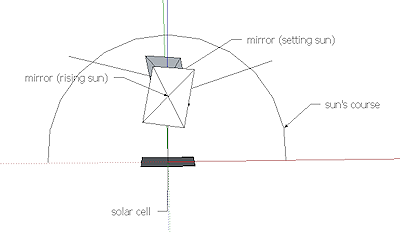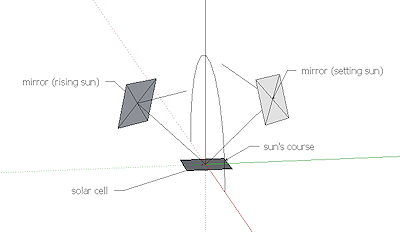I noticed a question recently about solar cells – specifically, how to improve cell efficiencies throughout the day?
Of course, mirrors, like magnifying lenses, are obvious solutions. More light on the solar cell, more power. But here’s the catch: The solar cell was fixed in place, no tracking allowed.
Researching on the Internet, it appears that tracking can add 40% to the output of a solar cell by keeping it facing the sun. Add to that the fact that cool solar cells generate more power than hot ones, and we have power problems (as this page’s charts suggest, the noon output can drop to early-morning levels if the cells aren’t cooled properly). Yet cooling can add complexity and expense – although one site suggested using water to cool the cells, generating household hot water in the process, an option that suggests an all-in one project in the future…
But back to the fixed cells. Although there are lots of solar trackers available (DIY or for a price), the fixed solar cell does present a challenge – how to get back that missing 40%? Mirrors still seem viable, but of course anywhere you place a mirror will in turn block the light at another part of the day.
Unless you think three dimensionally.
First off, if you wanted to focus the setting sun on the solar cell, you’d place a mirror on the East side of it, and angled so you maximize the setting sun’s light shining on the cell. But since you’d now block the rising sun with this mirror, you’d need to move it North of the cell, which requires yet another twist to take the setting sun and send it South (where the solar cell is).
Likewise, for the rising sun you’d use a similarly-twisted mirror facing in the opposite direction – in fact, a mirror image of the setup for the setting sun (sorry, could not/would not resist that one!)
The result is some weirdly angled mirrors, as shown in these images, but they would reflect a specific sun angle/time onto the cell, while keeping out of the sun’s path (the curve in the pictures):
(by the way, in these pictures, the solar cell and sun’s path seem flat, but this is only relative to the cell. The arc of the sun is normally tilted most places in the world, and the cell and mirrors would be tilted up to match that – it’s the East-West path of the sun we are concerned with here, so I left everything flat in the diagram)
The mirrors are angled on one axis at 45 degrees, but angled on a second axis so as to catch a specific angle of sunlight (in this case, the setting/rising sun at about 22.5 degrees from the horizon). Different angles, different placement. The result is an extra solar boost in the morn and night, with no loss of light during the rest of the day.
How is the efficiency? Well, light is less ‘potent’ (my technical term) early and late in the day, since the rays have to go through more of the atmosphere than when coming from overhead. As well, the mirrors take a smaller slice of the light that falls on them since they are at an angle. For instance, a mirror at 45 degrees is already cutting the light that falls on any given square inch to 70% of maximum. Add the other angle and you get down to about 60% (sine of 45 degrees times sine of 67.5 degrees, the other angle, viewed from North-South).
But, 60% light is still close to double what you’d normally get during that time of day (38%, or sine 22.5) – but since you’ve got BOTH light streams shining at the cell, you’re actually close to getting 100% of the light on the cell! So for as long as the mirror angles the light, you get about noon-time power from a fixed cell (ignoring the light’s potency, of course – there would need to be some real-world testing to see exactly how much power the setting sun could provide, for example…)
Can this be expanded? As long as the mirrors don’t get in each other’s way, you should be able to add more. Ultimately, you could perhaps create a cone-like curved mirror that would reflect nearly the whole day – but it’s too late/early in the morning for me to try to model that here…
So, large mirrors, or a solar tracker – your choice.


